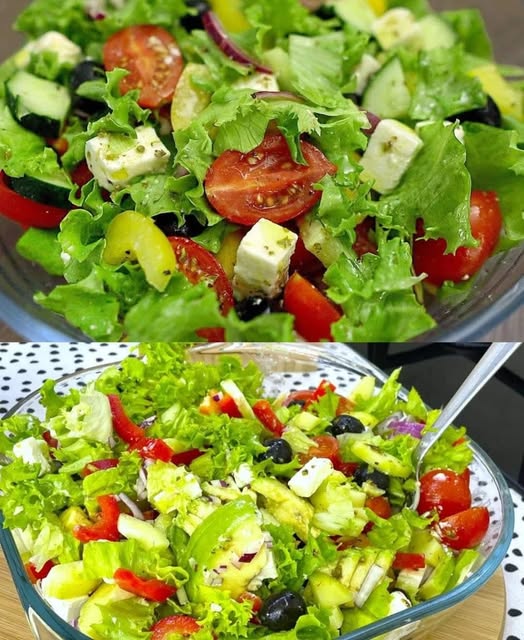ADVERTISEMENT
Fresh Salad from the Garden: With This Recipe, I Can Eat It for 12 Months – The Trick My Grandmother Taught Me!
Nothing beats the crisp, refreshing taste of a salad made with fresh ingredients from your garden. But what if you could enjoy that delicious, garden-fresh salad all year round, even in the middle of winter? Sounds too good to be true, right? Well, thanks to a simple trick my grandmother taught me, I’m able to enjoy fresh, garden-fresh salads every single month, no matter the season!
In this article, I’ll share the recipe for a garden salad that can be enjoyed all year long, thanks to my grandmother’s clever method for preserving fresh produce. With a little preparation, you’ll be able to savor the flavors of your garden throughout the entire year.
The Secret to Year-Round Fresh Salad: My Grandmother’s Trick
When I was growing up, my grandmother always had a garden full of vegetables. She grew everything from leafy greens like lettuce and spinach to tomatoes, cucumbers, and carrots. But what amazed me the most was how she always seemed to have fresh produce to make a salad, no matter the time of year.
The secret? Freezing and preserving vegetables at the peak of their freshness, so they could be used in salads even when the weather outside was too cold for gardening. My grandmother’s method is easy, effective, and keeps the salad ingredients crisp, flavorful, and ready to use at any time.
The Key Ingredients for a Year-Round Salad
To make a salad that you can enjoy for all 12 months, it’s important to choose the right ingredients. Some vegetables freeze better than others and retain their freshness and flavor when thawed. Here are the key ingredients you’ll need for your year-round salad:
- Lettuce (Romaine or Butterhead) – These leafy greens are perfect for freezing. Romaine and butterhead lettuce, in particular, freeze well and maintain their texture and flavor once thawed.
- Spinach – Spinach is another green that freezes well and retains its fresh taste even when you take it out of the freezer months later.
- Cucumbers – Cucumbers can be tricky, but when prepared correctly (peeled, seeded, and cut into small slices), they can be frozen and used in salads throughout the year.
- Tomatoes – Freezing tomatoes helps preserve their flavor. You can freeze whole tomatoes or chop them into small pieces before freezing.
- Carrots – Carrots can be sliced or shredded and frozen, keeping their crunch and sweet flavor intact.
- Bell Peppers – Bell peppers are perfect for freezing. Slice them into strips or dice them before freezing so they’re easy to add to your salad later.
- Herbs (like parsley or basil) – Fresh herbs like parsley or basil can be frozen in ice cube trays with a little water to preserve their flavor.
How to Prepare and Freeze Salad Ingredients
Now that we know which ingredients are perfect for freezing, let’s dive into how to prepare and preserve them for year-round use.
1. Prepare the Greens (Lettuce and Spinach)
- Lettuce: Wash the lettuce thoroughly, remove any wilted or damaged leaves, and chop it into your preferred size. Spin it dry in a salad spinner, then lay it out on a paper towel to absorb excess moisture. Once dry, spread the lettuce out in a single layer on a baking sheet and place it in the freezer for a couple of hours. Once frozen, transfer the lettuce to a freezer-safe bag or container.
- Spinach: Wash and trim the spinach, removing any tough stems. Blanch the spinach by placing it in boiling water for 1-2 minutes, then immediately transferring it to an ice bath to stop the cooking process. Once cooled, squeeze out the excess moisture and freeze the spinach in airtight bags or containers.
2. Prepare the Vegetables (Cucumbers, Carrots, Bell Peppers, and Tomatoes)
- Cucumbers: Peel the cucumbers, slice them in half, and remove the seeds. Cut them into thin slices or small cubes. Blanch them briefly in hot water (about 30 seconds) and then transfer them to ice water. Pat them dry and freeze in a single layer on a baking sheet. Once frozen, transfer them to a freezer-safe bag.
- Carrots: Peel and chop the carrots into slices or small chunks. Blanch them in boiling water for 2-3 minutes, then place them in an ice bath. Drain and dry them, then freeze them in bags or containers.
- Bell Peppers: Slice the bell peppers into strips or dice them. No blanching is needed—just chop and place the pieces on a baking sheet to freeze. Once frozen, transfer them to a storage bag or container.
- Tomatoes: You can freeze whole tomatoes or chop them into pieces. Blanch them first (for about 30 seconds) to make peeling easier, then place them on a tray to freeze. Once frozen, store them in freezer bags or containers.
3. Freeze Fresh Herbs
Herbs like parsley or basil are perfect for freezing, too. Simply chop the herbs and freeze them in ice cube trays with a little bit of water or olive oil. Once frozen, transfer the cubes into bags for easy use later.
4. Label and Store
Label your bags or containers with the contents and the date they were frozen. Properly sealed and labeled ingredients will last for up to 12 months, ensuring you have a steady supply of fresh salad ingredients year-round.
For Complete Cooking STEPS Please Head On Over To Nex
ADVERTISEMENT
ADVERTISEMENT
